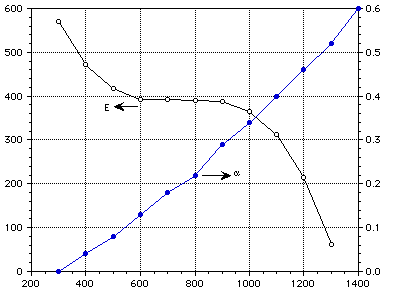 (1-7)
(1-7)Silicon carbide and silicon carbide fibre reinforced composites are considered as potential candidate structural and high heat flux materials for future fusion power stations, because:
1. Several neutronic and conceptual fusion reactor studies have concluded that the postshutdown levels of activation of first wall-blanket structures made of pure SiC are considerably lower than those of any metallic alloy presently considered for fusion.
2. Capability to operate at very high temperatures. Typical operating and anticipated temperatures are between 1000 - 1500 C, whereas non-refractory metals do not exceed operating temperatures of about 600 C. Temperatures approaching 1000 C lead to improved thermal cycle conversion efficiency.
Despite the above mentioned advantages of SiC ceramics over metals, their brittle fracture behaviour yields wide statistical distributions of fracture tensile strength values, making the points of failure unpredictible. Furthermore, failure of monolithic ceramic materials through the mechanism of crack propagation is rapid through the entire stressed region. To alleviate these two concerns, worldwide research & development programs have been intensified using two different approaches :
1. Development of high-performance monolithic ceramics, aiming to reduce fabrication induced flaws, minimize volume changes during manufacturing, develop shape processing techniques, improve sintering aids and develop transformation-toughened and particle-toughened ceramics.
2. Development of reinforced ceramic composites with predictable performance characteristics through the use of fibres dispersed in the ceramic matrix. High strength can be achieved by transferring the load from the matrix to the fibres, taking advantage of the superior tensile strength of the fibers.
Coolant Compatibility
SiC has excellent resistance to oxidation up to 1000 C mainly due to the formation of a protective stable SiO2 layer. The stability of the SiO2 layer is dependent on the O2 partial pressure. It is unstable at pressures lower than 10-10 - 10-8 atm. Compatibility studies of SiC in molten Li indicated that intergranular penetration degrades the fracture strength.
DATA AND CORRELATIONS
SiC is known to have high intrinsic strength and stiffness (E = 450 GPa @ RT), high temperature stability (decomposition temperature is 2830 C) and excellent oxidation resistance. The relatively high thermal conductivity (k = 0.25 W/cm-C @ 200 C) and low coefficient of thermal expansion ([[alpha]] = 3.8x10-6 m/m-K @ 200 C) result in favorable thermal shock resistance when compared to other ceramic materials.
Figures 1-3 show the variation of properties with temperature. The thermal conductivity k (W/cm-C), specific heat, c (J/kg-C), fracture stress, elastic modulus and swelling are given by empirical equations of the form ref [1]
 (1-7)
(1-7)
with T the temperature in C and values of coefficients as follows:
Coeff k (1) Unirrad c (3) Sf (MPa) E (5) Swelling dV/V
(2) Irrad (4) (6)
(7)
W/m-C J/kg-C MPa GPa < 1000 C > 1000 C
a0 209.3 22.62 435.53 -993.9 605.632 1.43 -71.19
a1 -0.319 -0.0282 3.08 7.42 -1.407 0.0059 0.15
a2 2.6x10-4 1.39x10-5 -0.0047 -0.013 0.003 -1.56x10-9 1.09x10-4
a3 -1.3x10-7 8.3x10-9 3.31x10-6 9.54x10-6 -2.09x10-6 8.58x10-9 2.56x10-8
a4 2.6x10-11 -2.28x10-12 -8.41x10-10 -2.42x10-9 0.0 0.0 0.0
Polynomial correlations of the thermal and structural properties as functions of temperature, using data from refs [2, 3], are as follows:
 (8)
(8)
 (9)
(9)
 (10)
(10)
with all temperatures in Eqs 8-10 in degrees K. Equations (1), (3) and (10) have limits between 300-1800 K and Eq (5) between 300-1300 K.
TABLE 1 Thermal and structural properties of silicon carbide
T K [[rho]] E GPa [[nu]] k W/m-K c J/kg-K Sf MPa [[alpha]]
kg/m3 (10-6)
m/m-K
300 3160 569.98 490.00 675.40 0.000
400 471.16 252.32 808.32 0.040
500 416.44 186.71 965.00 125.30 0.080
600 393.27 160.29 1043.00 348.02 0.130
700 391.43 140.20 1100.00 466.33 0.180
800 389.11 119.27 1144.00 515.57 0.220
900 387.68 102.11 1179.00 525.29 0.290
1000 365.32 86.21 1208.00 519.22 0.340
1100 311.82 70.73 1232.00 515.30 0.400
1200 214.63 57.75 1253.00 525.64 0.460
1300 61.21 46.04 1271.00 556.56 0.520
1400 35.15 1286.00 608.55 0.600
1500 27.62 1300.00 676.33 0.650
1600 21.76 1313.00 748.77 0.710
1700 16.74 1324.00 808.96 0.760
1800 12.56 1335.00 834.17 0.830
k (W/m-K) c (J/kg-K)

Temperature (K)
Figure 1 : Thermal conductivity and specific heat of silicon carbide.
E (GPa) [[alpha]] (10-6 m/m-K)

Temperature (K)
Figure 2 : Elastic modulus and thermal expansion coefficient of silicon carbide.

Temperature (K)
Figure 3 : Fracture stress of silicon carbide.